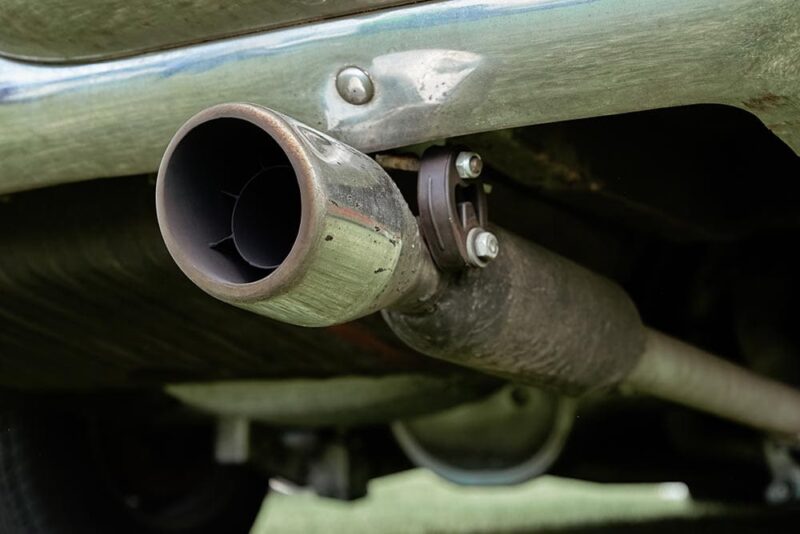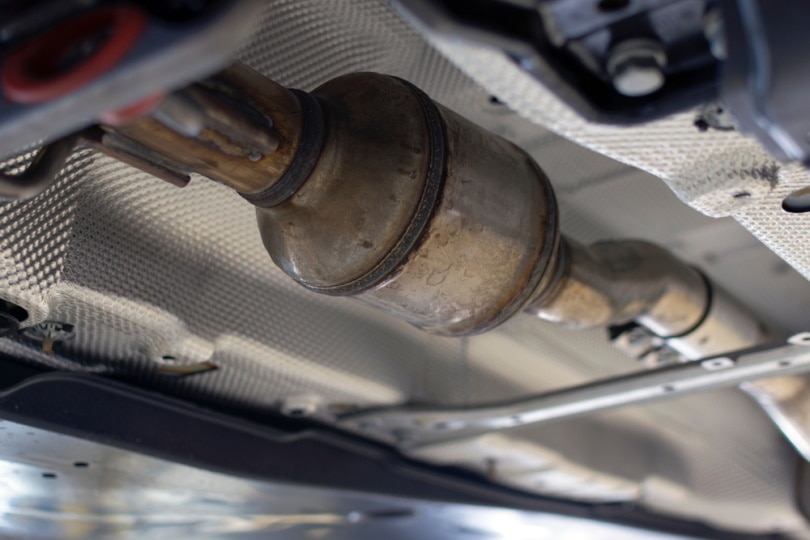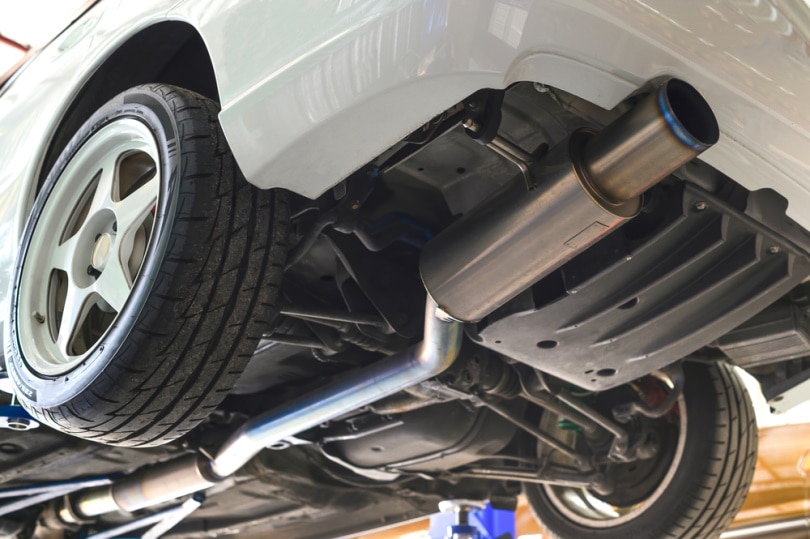Muffler vs Catalytic Converter: What’s the Difference?
-
Visnja Radosavljevic
- Last updated:

Both the muffler and catalytic converter are located on the exhaust pipe of your vehicle. Although they might appear similar, they have different functions that help your exhaust system function properly. As they’re parts that are placed close to one another, it might be hard to spot their differences straight away, so we wanted to provide some more details about each.
The primary function of the muffler is to lower the noises coming from the engine, while the catalytic converter reduces the gases coming from the exhaust system.
Check out the rest of the differences and an explanation for each part below.

Overview of a Muffler
A muffler is a part of the vehicle’s exhaust system that reduces the noise level coming from your engine while the car is running. It’s located on your car’s exhaust pipe, and it absorbs the sound waves that your exhaust system releases. That’s why many people also refer to a muffler as a silencer.

How Does It Work?
When your engine is running, the sound waves will travel throughout the exhaust system and pass through the muffler, which will dampen the noise. The actual process that happens inside the muffler will depend on the type of muffler your vehicle uses.
There are three different muffler types typically used for vehicles:
- Chambered muffler: These mufflers have a series of internal baffles and/or chambers. When the pulse coming from the exhaust enters the muffler, the waves move and reflect through cavities and walls, bouncing against each other. That way, they cancel each other out, reducing the noise along the way.
- Turbo muffler: These mufflers typically have internal tubes with a snake-like pattern, so the sound waves travel throughout it in an S shape. The inlet tube directs the waves to an open chamber that diverts the sound flow 180 degrees through the second tube, where the same thing happens throughout the third tube, after which the waves leave the muffler.
- Straight-through muffler: These mufflers offer a direct pathway for the sound waves to exit the muffler without any wave-reflective walls or diversions. The internal material of straight-through mufflers is covered in a noise-deadening material that reduces the amount of sound coming out.

Issues You May Face When Driving Without a Muffler
Driving without a muffler can be extremely dangerous, so you shouldn’t do it unless there’s no other option. One of the main problems will be the noise levels, but other typical issues of driving without a muffler include:
- Increased pollution
- Reduced fuel economy
- Bad environmental impact
- Decreased vehicle performance
- Release of toxic fumes

Overview of a Catalytic Converter
A catalytic converter is a part of the vehicle’s exhaust system that reduces the toxic gases that are released into the atmosphere. It’s located between the muffler and the engine and contains honeycomb cells made of ceramics. They are coated with valuable metals such as platinum, palladium, or rhodium.
It converts harmful gases into harmless ones such as water, CO₂, and N₂ through oxidation and reduction.

How Does It Work?
The primary function of the catalytic converter is to convert toxic gases into ones that are not harmful to the environment. Similar to a muffler, the working process of a catalytic converter will depend on the type your vehicle uses.
There are three different types of catalytic converters commonly used for vehicles:
- Three-way catalytic converter: This is an ideal catalytic converter as it turns CO, HC, and NOₓ into harmless substances. This catalytic converter works converts CO, HC, and NOₓ into H₂O, CO₂, and N₂.
- Oxidation catalyst converter: This catalytic converter reacts through oxidation, making CO and HC into substances such as CO₂ and H₂O that don’t cause pollution. The exhaust manifold should have pure air for the process to function correctly. Also, the gas coming from the exhaust needs to be recirculated along with the EGR system. That’s because the EGR system slightly reduces NOₓ.
- Three-way and oxidation catalyst converter: This is a combination of the oxidation and three-way catalyst converter. The combined powers of both types are mixed into one that optimally reduces pollution.

Issues You May Face When Driving Without a Catalytic Converter
Driving a vehicle without a catalytic converter can cause severe issues, so it’s best to avoid it at all times. Although it’s something you can technically do, driving without it is illegal. Other typical issues of driving without a catalytic converter:
- Rough driving
- Uneven acceleration
- Reduced engine performance
- Failing the vehicle emissions test
- Engine misfiring

Muffler vs Catalytic Converter – The Biggest Differences
By now, you realize that although these exhaust parts are located near one another, they have entirely different functions. However, your car needs both to function correctly, and you could face serious issues if you drive without one.
| Differences | Muffler | Catalytic converter |
| Function | Reduces the noise level coming from the vehicle’s engine | Converts the harmful gases from the car into non-harmful ones |
| Working concept | Internal components destroy the sound waves and lower their friction | Internal components turn to oxidation and reduction to reduce the emissions and convert the harmful gases into harmless gases |
| Process type | A physical process | A chemical process |
| Assembly | Depending on the type, it’s made of internal tubes, bafflers, or chambers | Honeycomb structure with different processes depending on the type |
| Material | Cast iron, aluminized steel | Palladium, platinum, rhodium |
| Location | At the end of the exhaust system | Between the engine and the muffler |
| Life expectancy | Typically lasts 4 to 5 years | Typically lasts for 5 to 20 years |
| Possible reasons for failure | Moisture, corrosion | Overheating, contamination, choking |
Function
A muffler will reduce the sounds coming from your engine and make them insignificant compared to how they would sound if there was no muffler or if the muffler was damaged. A catalytic converter will convert dangerous gases into harmless ones, causing less pollution and leaving a better impact on the environment.
As they have different functions, their operating system is pretty different, as the process that happens in a muffler is physical. In contrast, the catalytic converter has a chemical process when operating. The muffler relies on its internal components to reduce the noise, while the catalytic converter relies on oxidation and reduction, which are chemical procedures.

Lifespan and cost
When it comes to the lifespan and cost of these parts, typically, mufflers are cheaper to replace, but they have a shorter lifespan. A well-maintained muffler will last about 4 to 5 years, while a brand-new muffler will last you for at least 50,000 to 80,000 miles.
When it comes to catalytic converters, they are commonly more expensive to replace due to the precious metals inside them. Their lifespan will depend on maintenance and driving conditions, lasting anywhere from 5 to 20 years. If you keep it in good condition, you will prolong its lifespan. However, we still suggest checking it every 50,000 miles to ensure everything functions as it should.

Conclusion
The muffler and catalytic converter are two different components that are vital for your vehicle to function properly. They work together to prevent pollution and reduce the noise and harmful gases coming from your car. Also, both of these exhaust parts will improve the overall performance of your vehicle, so it’s essential to keep them in good shape. Keep that in mind and perform regular maintenance to make your car more efficient.
Featured Image Credit: (L) Jong42, Shutterstock | (R) Ulianenko Dmitrii, Pixabay
Contents
